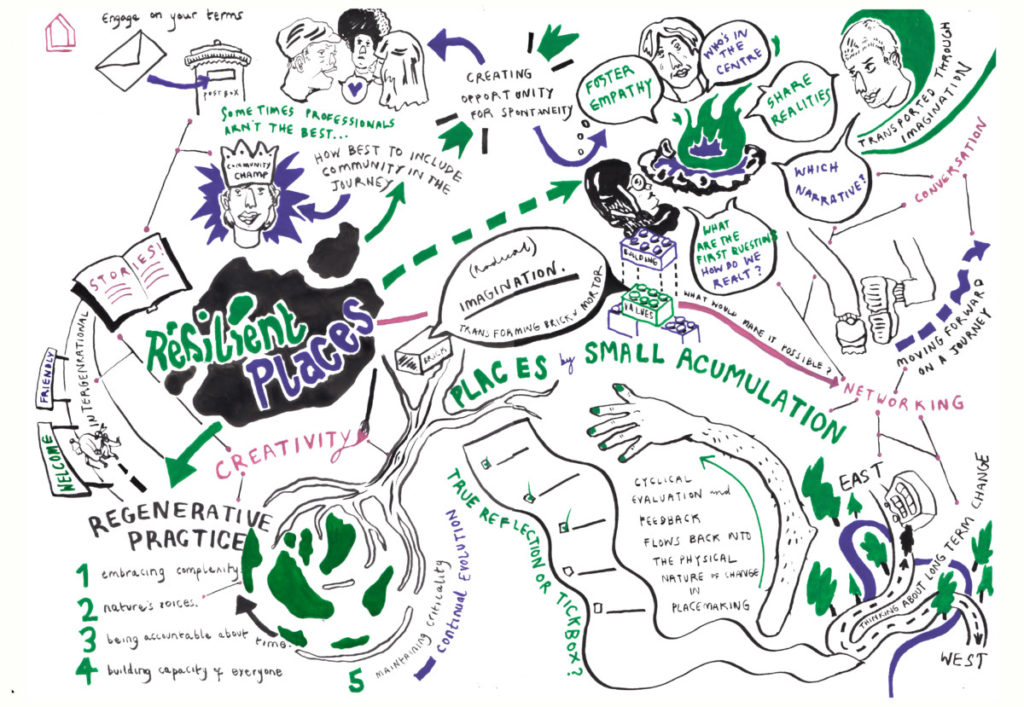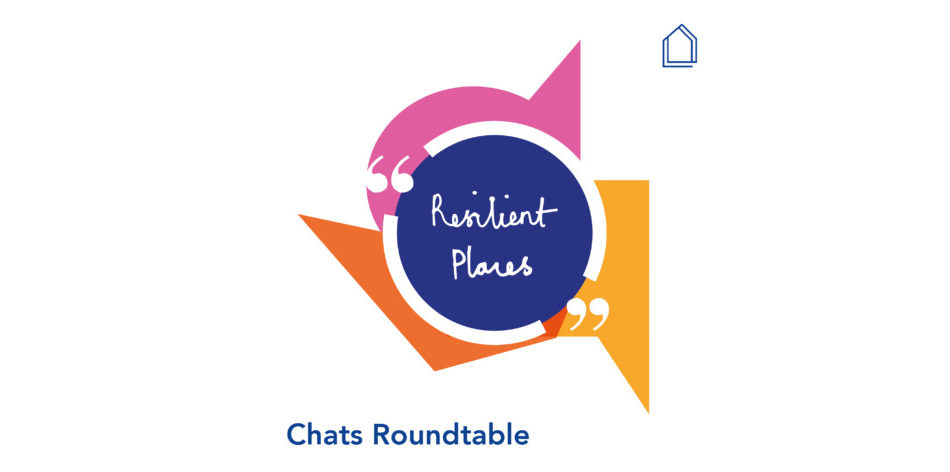Written by:

Over the last 10 months, our third series of Glass-House Chats have been exploring a host of different topics, from how we amplify different voices within the built environment, such as young people’s voices or voice of nature, to how we challenge stereotypes and break down barriers within placemaking. For our final Chat of the series, we wanted to explore a different format that, whilst keeping the conversational essence of the Chat, highlighted some of the fantastic voices and ideas that have emerged over the course of the series.
We invited four of our previous attendees, who hail from an assortment of backgrounds including; spatial and academic, local authority, community, and art and public realm. They each offered a short two minute verbal provocation reflecting on the Chat(s) they had attended, what resonated with them from that conversation and an idea or theme they felt was important to share further.
We were joined by a wonderful group of participants for our final Chat, with many familiar faces but also some new attendees, from across a variety of different backgrounds, sectors and disciplines. Alongside our four provocateurs, we threaded together ideas from across the series around resilient places. What does resilience mean in placemaking, and how do different components of the built environment, human and non-human experience feed into creating resilient places both now and in the future?
Regenerative Regeneration: Starting from Principles
Our first provocateur comes from an architectural practice and academic research background, and reflected on their current work which explores regeneration along high streets. They offered us five principles to reconsider places which succinctly aligned with many of our Chat topics from this series.
The first, Embracing Complexity highlights many of the themes we discussed during our Relearning Places Chat in February, exploring how we see ourselves as embedded in places and what rituals we might use to connect ourselves to places through our senses. The second, Being in Relation with Ecosystem resonated with ‘How Can We Co-design with Nature?’, where we spoke of seeing ourselves as not separate to nature but instead part of an ecological system which enabled us all to thrive. Being Accountable Across Time related to our ‘What is a Resilient City’ Chat last month, where we explored the pitfalls of short-term-ism and how we must strive to act both locally and in the long-term. Imagining and Acting Collectively builds on some of the themes explored in ‘Co-design Legacies: What Happens Next?’ and the need to build capacities of everyone, not just involved communities. Finally, Maintaining Criticality linked to our ‘Building Green Equitable Futures’ Chat, where we discussed the need for an openness to unlearn and question our assumptions, exploring issues of ownership and looking at nature through a fiscal lens.
The first provocation provided a set of shifting and ever-evolving values through which we can look at and act within placemaking, and promoted rich debate within our attendees about how we can shift from toolkits to frameworks such as this to evaluate the diversity of things that make up places.
Engaging on Others Terms
Our next provocateurs come from an arts and public realm-based placemaking practice. They reflected on their own experience of creating community-based public art projects to question how best communities can be supported by art, asking when and how is the best time to involve people in their process. Often, their work means that they are painting and creating in very public spaces, which they have found to be one of the most effective ways of engaging a wide range and breadth of people. However, they also reflected on how they are sometimes not best placed to lead that engagement, and recognise the need to step back to make space for local champions.
This promoted a great conversation on how and when we engage people in design conversations and processes, and the humility that is needed within each of our own practices to step back to make room for those better placed or connected to engage. We also spoke about the importance of offering different levels of engagement, and how whilst some might be comfortable starting a conversation on the street, others might find it more comfortable to write a message or engage online.
Nurturing Empathy and Transforming Narratives
Our third provocateur reflected on their attendance at our ‘How Can We Use Stories to Change Places?’ by encouraging us to pay more attention to ours and others’ stories, arguing that this is an integral part of being human and making sense of the world around us. Stories can help us share our truths and experiences, holding the power to move us emotionally. In relation to placemaking, we can use stories to ask questions like “how do we want to live together?”, “whose framework are we functioning in?” and “how can we move beyond dreaming to create the future world we want to see?”. They reflected on their own work within a local authority context to convey the importance of using stories to dream big and then connect the dots between these ideas. They acknowledged how essential it is to create a shared narrative that includes people and brings them along within placemaking journeys.
We spoke about the importance of making space for intuition, as well as pushing ourselves out of our ‘normal’ narratives, out of our everyday lives to understand someone else’s perspective and experience. We agreed that in doing this, in remaining open to ideas and projects outside our usual wheelhouse, we can make space for a richer and more diverse built environment. If instead of shutting down ideas outside of our understanding or remit, we instead asked ‘what would we need to do to make this possible?’, we can create a more diverse ecosystem of places.
Connecting the Dots: What Resilient Places Look Like
Our final provocateur comes from a community organisation background, and asked our attendees, “how can we contribute to creating resilient places and communities by building and sustaining places and spaces which are welcoming, friendly, affordable and accessible for people of all ages?”. They used the opportunity of being last to succinctly sum up themes from the previous speakers in four words; conversations, networking, creativity and stories. Interestingly, these also could be seen as the answer to our provocateur’s question.
Through having conversations, creating wide and interconnected networks, approaching challenges with creativity and utilising the power of stories, we can create and maintain resilient places and communities within them.
We talked of the importance of how these four words, or principles, related to our first provocateurs principles of regeneration. We agreed that the power of using principle-led evaluation, or values, when approaching placemaking is that they allow each place-based outcome to be completely bespoke, shaped by the unique people and information fed into the process. Approaching placemaking with values also means approaching projects with a process, rather than a predetermined outcome. This allows space for spontaneity and serendipity, to create places that respond to people rather than tell them what they need.
Wrapping Up
Our final Chat brought together so many threads of conversation from across the series, alongside returning and new participants for an engaged and passionate conversation under the umbrella of Resilient Places. We have found these Chats to be wonderful places for connection and conversation, an ‘online fire pit’ of connecting and sharing realities with a diverse array of people from different walks of life and disciplines. All of which hold different perspectives and valuable experiences of placemaking.
The Roundtable was truly a celebration of everything that our Chats aim to achieve. As we reflected on both the provocations from our returning attendees and themes highlighted throughout the season, we were collectively struck by the power and importance of art, of shared empathy and storytelling, within our places. We should rely on one another, on our individual strengths and our collective power to bring change into a multitude of spaces, to value spontaneity and create spaces for curiosity and sharing. To understand that life is nonlinear and therefore creates more space for messiness and ‘failure’ (which is really just experience and growth). If we approach perceived problems with a ‘what would make it possible’ attitude and remain hopeful, we can make places with people that are rich and resilient.
A huge thank you to all of our attendees, both at this final Roundtable and at every Chat throughout the series. Our Chats will be back later this year for a fourth series, so if you have any ideas or suggestions for future Chat topics, please drop us a line at info@theglasshouse.org.uk.

